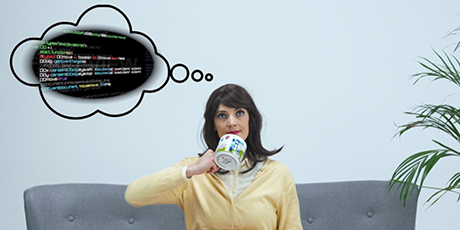The humanoid robot Vera dances knowledge about AI into children and young people in new educational material. Two DTU students have made the abstract concrete. They hope to increase our awareness of what AI is able to - and does.
When we trawl our feed on the ‘free’ social media, we pay with our time and data. Our movements and likes are monitored and analyzed with artificial intelligence (AI), so we are exposed to more of the same that we already see. The information is sold to companies that will influence us to buy goods or think something specific. Our data is the gasoline of artificial intelligence - without data no AI-based business.
But even though AI is often singled out as a villain, AI is really just formulas with math and statistics. There is no ‘hocus pocus on artificial intelligence, explains Sebastian Ray Mason and Andreas Tuxen, who are studying for the bachelor's degree in Artificial Intelligence and Data and the master's degree in Autonomous Systems, respectively.
Last summer, they were hired for an unusual student job to help a dance theater with ideas for teaching materials for children and young people about the meeting between man and artificial intelligence. The dance theater had previously made the performance ‘Humanoid’ about the humanoid robot Vera, who dances electric boogie, a style where you move in small jerks. Dancer and choreographer from Offspring Production Julie Kunz was going to play Vera again - in AI with Vera (Danish) - and would like some input.
“We have provided inspiration to draw AI down to a non-scientific level and make the abstract concrete. The videos should show what artificial intelligence is, what it can and cannot, and where we meet it in our everyday lives today and in the future,” Sebastian explains, and Andreas adds:
"Often you may have a tendency to attribute to robots an enormous amount of intelligence, and a lot of properties that they do not have, and where you expect them to react in a science fiction-like way. We want to help demystify what AI is. These are statistical models, and mathematics can do a lot, but not everything.”
Vera's limitations
In four videos of about ten minutes each of them guides us around the AI universe, while Vera dances her way through the themes, and along the way is joined by Henning, a curious, sweet, and comical human. While Henning is able to think creatively, e.g. as he has to assemble furniture and follows his intuition, Vera follows the building instructions using a logical algorithm.
"It's a gimmick for making some fun. The point is to show what Vera is good at, and what Henning is good at, and how much smarter human is; even though his furniture will be finished later and is a bit cracked,” Andreas explains.

Credit: AI med Vera, Offspring Production / Julie Kunz
He and Sebastian think it has been fun working with AI in a multidisciplinary way, uniting multiple universes.
"Often children and young people talk about AI as a robot overlord who wants to take over the world. It is fun to think in worst-case scenarios, but in our optics, best-case scenarios are the most exciting, and here the teaching material also offers some suggestions."
Sebastian Ray Mason, studying on bachelor's degree in Artificial Intelligence and Data at DTU Compute
"If you talk in a high level of abstraction about taking some samples from a distribution, others may not know what a distribution is, just as they do not know that it is an algorithm that makes the decisions in AI - and that the system behaves logically,” says Sebastian.
The idea is that the four videos can be used in teaching between the ages of 12-18 and are followed by a school course on artificial intelligence, where pupils learn to be critical of AI but also see where in society AI can make a difference. Perhaps they would like to study math and programming themselves one day.
"Often children and young people talk about AI as a robot overlord who wants to take over the world. It is fun to think in worst-case scenarios, but in our optics, best-case scenarios are the most exciting, and here the teaching material also offers some suggestions,” says Sebastian.
Responsible AI
Recently, the European Commission presented proposals for rules and measures 'to turn Europe into the global hub for trustworthy Artificial Intelligence (AI)''. The EU will strengthen investment, innovation, and the spread of AI in a way that guarantees security and fundamental rights for citizens and businesses.
Responsible AI is also a theme that researchers from DTU Compute have put on the agenda with a new series of webinars together with the country's other universities.Learn more in the fact box.
The Vera videos also look at AI and ethics, and the topic concerns both DTU students, who point to the need to think more about ethics into AI, for example, on social media.
"Today, channels like YouTube act as an infinite echo chamber, where we almost just hear our own voices and are presented with the same attitudes that we already have. I think it could be good if AI could connect the different bubbles on social platforms so we could easily look outside our own bubbles and see what others are looking at. Today, you need to take an active decision to look for something new, but what should you look for? ” says Sebastian.
Sebastian and Andreas hope that teaching materials like 'AI with Vera' will help make both children and adults more aware of whether we really bother to watch another video since we only see it because 'hundreds of engineers' constantly trying to keep our attention.

Credit: AI med Vera, Offspring Production / Julie Kunz
The two students themselves only use social media as a communication platform for appointments with friends and fellow students, because at the moment it is very difficult to delete data and be completely anonymous on a platform.
“GDPR helps us a little, but data we leave on the platforms we use will remain the platform's data if we do not ask them to remove it. If you do not 'clean up' after yourself and actively redefine yourself on the internet, it can end up with AI shaping you,” says Sebastian.
- The teaching material AI with Vera consists of four video episodes (Danish) of approximately ten minutes each.
- The videos are a mix of dance, graphics, music, and humor and targeted at children and young people aged 12-18.
- The episodes are divided into the themes: What is AI, Al in your everyday life, AI and jobs, and AI and Ethics.
- Vera is played by electric boogie dancer and choreographer from Offspring Production Julie Kunz, who also got the idea and the videos were made in collaboration with Uppercut Dance Theater in Copenhagen.
- The dance theater has received help for the script from the two DTU students Sebastian Ray Mason from the bachelor's program in Artificial Intelligence and Data at DTU Compute and Andreas Tuxen, who is studying for the master's program in Autonomous Systems at DTU Elektro.
- The AI information is fact-checked by Professor at DTU Compute Ole Winther, Anders Kofod-Petersen, AI researcher at Alexandra Institute and Professor of artificial intelligence at the Norwegian University of Science and Technology and Gianluca Mauro, Engineer, Author, and CEO at AI Academy.
- The teaching material is free. But you can support the artists with a contribution. At the same time, the artists pass on 30 percent of the contributions to the organization Black Girls Code, which works to prevent prejudiced AI. It is an American organization that works to increase the number of women with skin color other than white in the tech industry.
- The project is funded by the Augustinus Foundation
Read more and watch the videos at https://www.ai-vera.com/